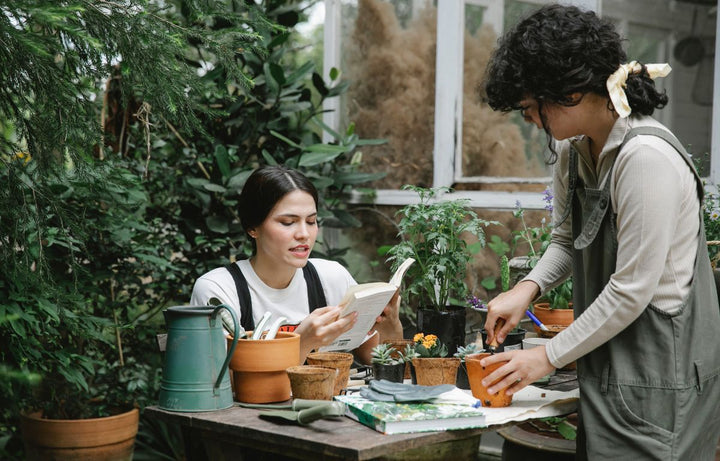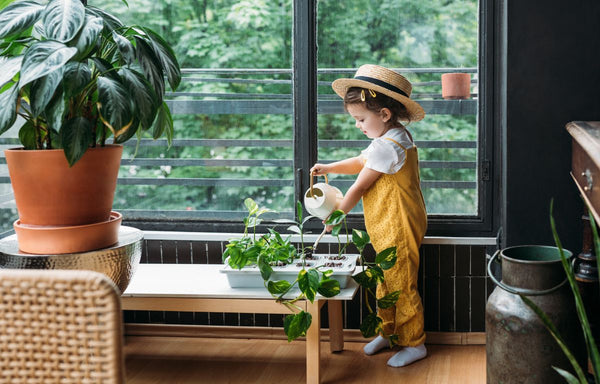
Demystifying Plant Care Terminology
Demystifying Plant Care Terminology
Caring for plants can be a rewarding and fulfilling endeavour, but it often comes with a plethora of jargon and technical terms that might seem overwhelming to beginners. Whether you're a seasoned plant parent or just starting your green journey, understanding plant caring terminology is essential to nurturing thriving and lush greenery. In this guide, we'll break down the key terms to make it easy to grasp and implement in your plant care routine.

Positioning and Growing Conditions:
-
Light Requirements: Understanding the specific sunlight or
UV light needs of your plant – whether it requires direct light, indirect
light, or shade.
-
Insufficient Light: Inadequate light exposure can lead to
weak growth, leggy plants, and a lack of flowering or fruiting.
-
Too Much Light: Intense direct sunlight can scorch leaves,
causing them to develop brown or yellow spots and potentially leading to
leaf drop.
-
Microclimates: Pockets of varying environmental conditions
within your home, such as near windows, heaters, or air vents.
-
Zoning: Placing plants with similar light and humidity
preferences together creates mini ecosystems that promote healthy growth.
-
Temperature Range: Providing plants with the appropriate
temperature range for their species, considering daytime and night-time
variations.
- Air Circulation: Air movement around plants to prevent stagnant air pockets that can lead to mould and other issues.
Watering and Humidity:
-
Humidity Preference: A plant's preference for low or high
humidity levels needed to keep the stem and foliage hydrated.
-
Hydration: Providing plants with the right amount of water
and humidity to sustain their growth.
-
Overwatering: Giving plants more water than they can
readily absorb, resulting in excess water collecting at the bottom of the
pot and waterlogging the soil.
-
Underwatering: Not providing enough water for the plant to
drink. The soil becomes dry quickly, causing the plant to dehydrate.
-
Drainage: Allowing excess water to escape from the plant's
container to prevent waterlogging.
-
Misting: Gently spraying water on the foliage and stems to
increase humidity around the plant. Commonly use a spray bottle or a plant
mister.
-
Watering Schedule: A consistent watering routine based on
your plant's needs and the environmental conditions in your home.
-
Bottom/Reverse Watering: Allowing plants to absorb water
from the bottom of the pot rather than watering the top of the soil.
Commonly done by submerging the bottom of the plant in a shallowly filled
bathtub, bucket or pot tray.
- Watering Indicators: Monitoring soil moisture through touch, moisture meters, or observing signs of wilting or dryness in the plant.
Soil and Fertilisation:
-
Potting Mix: A blend of materials used to support plant
growth in containers. The materials often vary depending on the type of
plant.
-
Well-Draining Soil: A potting soil with materials that
allow for aeration, moisture retention and drainage while maintaining
essential nutrients. Often used for pot planting indoors and outdoors.
-
Aeration: Loosening soil to form small pockets of air to
enhance air circulation and root development.
-
Fertiliser: Nutrient-rich supplements added to soil to
provide plants with additional nourishment, boosting foliage development and
growth. often used as a liquid concentrate or pellet form.
-
Compost: Nutrient-rich, organic material created through the decomposition of
organic matter such as food waste and animal manure.
-
Perlite: A
lightweight, porous volcanic glass added to potting mixes to improve water
drainage and aeration.
-
Vermiculite: A naturally forming mineral that is used in
potting mix to absorb and store excess moisture and nutrients, which is
then slowly released back into the soil.
-
Sphagnum Moss: moisture-retaining material harvested from bogs,
used in gardening to enhance soil moisture, air circulation, and root
development for various plants.
- Scoria: Scoria is a volcanic rock with a porous texture, often mixed in with soil for better drainage and aeration.

Plant Biology:
-
Node: The point on a stem where leaves, branches, or flowers emerge. Often the
best place to make cuttings for propagation.
-
Bulbs:
A plant bulb is a specialised underground storage structure that contains
all the necessary nutrients and embryonic plant parts needed to produce a
new plant when conditions are favourable.
-
Rhizomes: Rhizomes are horizontal, underground stems
that serve as storage organs and can produce new shoots and roots,
allowing plants to spread and regenerate.
-
Roots: Roots anchor themselves in the soil, absorb water
and essential nutrients, and provide stability and support for their
above-ground growth.
-
Leaf/Leaves: Capture sunlight to carry out
photosynthesis.
-
Frond: A plant frond is a leafy, often fern-like
structure composed of numerous smaller leaflets attached to a central
stem.
-
Stems: Stems transport water, nutrients, and sugars
between a plant's roots and leaves.
-
Rosette: a circular arrangement of leaves or petals that
radiate from a central point as seen with Cabbage Roses and Agave.
- Propagation: Creating new plants from existing ones, often through methods like stem cuttings or root division.
Pot Planting and Maintenance:
-
Potting: Refers to the process of placing a plant into a container, usually a pot,
filled with a specialised growing medium to provide it with a stable
environment for growth.
-
Up-potting/Re-potting: Moving a plant to a larger container
to accommodate its growing root system and provide more space for future
growth.
-
Pot Selection: Choosing a pot with proper drainage holes
and an appropriate size – generally, one that's 5cm larger in diameter than
the current pot.
- Transplant/Pot Shock: Refers to the stress and temporary setback experienced by a plant when it's moved from one container or location to another.
-
Adaptation Period: The period in which a plant needs to
adjust to new conditions and locations.
-
Tease Roots: Loosening the root ball slightly during
repotting to encourage new root growth and prevent roots from circling.
-
Rootbound/Potbound:
When a plant's roots outgrow the pot, they become tangled and restricted,
leading to stunted growth and decreased water uptake.
-
Pruning: Trimming or cutting parts of the plant, such as
leaves, stems, or flowers, to encourage healthy growth.
-
Deadheading: Removing faded or spent flowers to promote new
blooms.
-
Repotting: Transferring a plant to a larger container to
accommodate its growing roots.
-
Staking: Using supports to help tall or climbing plants
maintain an upright position.
-
Photosynthesis: The process by which plants convert sunlight or UV light energy into
chemical energy, producing oxygen and glucose as essential byproducts.
- Air Purification: A natural process called phytoremediation, where plants absorb pollutants from the air and soil, filtering out harmful substances and releasing clean oxygen as a byproduct.
Problems:
-
Pests: Insects, mites, or other organisms that harm plants
by feeding on them.
-
Integrated Pest Management (IPM): A holistic approach to
managing pests using a combination of strategies, including biological
control and cultural practices.
-
Chilling Disease: A
condition where sensitive plants are exposed to temperatures slightly
above freezing, causing cellular damage.
-
Diseases: Fungal, bacterial, or viral infections can cause
symptoms like yellowing leaves, black spots, and wilting, leading to a
decline in plant health.
-
Fungicide/Pesticide: A naturally produced or man-made
chemical substance used to prevent or control fungal and bacterial diseases,
and eliminate insects and pests from invading plants.
-
Neem Oil: A commonly used natural remedy derived from neem
trees, used to control various plant pests and fungal diseases.
-
Mould: Mould in plants refers to the growth of fungal
organisms that can develop on plant surfaces or within the soil. Often
appear powdery or as black and grey spots.
-
Nutrient Deficiency: This occurs
when a plant doesn't receive an adequate amount of essential nutrients,
such as nitrogen, phosphorus, or potassium.
- Stunted Growth: Slow or reduced growth caused by factors like poor soil quality, insufficient light, improper watering, or nutrient deficiencies.

Plants Types:
-
Shrubs: Shrubs are woody plants that are smaller than trees
and have multiple stems arising from the base.
-
Trees: Trees are tall, woody plants with a single main stem
or trunk supporting branches and leaves, and often bear fruits, flowers, or
nuts.
-
Climbers/Vines: Climbing plants use various mechanisms,
such as tendrils, to attach themselves to surfaces and grow vertically.
-
Aquatic Plants: These plants thrive in water or aquatic
environments, ranging from fully submerged to partially floating.
-
Houseplants: Plants cultivated indoors, typically for decorative purposes, improving
indoor air quality, and creating a more pleasant living environment.
-
Succulents: Succulents store water in their leaves, stems,
or roots, allowing them to withstand dry conditions but are very sensitive
to frost.
-
Ferns: A fern is a type of non-flowering vascular plant
that reproduces via spores and is characterized by its feathery or lacy
fronds.
-
Palms: A palm is a type of tropical or subtropical tree
known for its distinctive feather-like, paddle, or fan-shaped leaves, tall
and slender trunk and typically grows in warm climates.
-
Cacti/Cactus: A cactus is a drought-tolerant type of
succulent plant adapted to arid environments, recognised by its thick,
water-storing stem, often covered in spines or needles.
- Herbs: A herb is a type of plant with soft, non-woody stems and leaves, often used for culinary, medicinal, or aromatic purposes.
Seasons and Climates:
-
Perennials: Perennials are plants that live for multiple
years, often dying back in winter and regrowing in spring.
-
Annuals: Annual plants complete their life cycle in a
single growing season. They sprout, flower, set seed, and die within a year.
-
Biennials: Biennial plants have a two-year life cycle. They
grow leaves in the first year, overwinter, then flower and produce seeds in
the second year before dying.
-
Arid Climate: Adapted to thrive in dry and high heat
temperature conditions. Plants often feature specialised traits like water
storage, reduced leaf surface, and drought resistance like cacti.
-
Temperate Climate: Characterised by moderate
temperatures with distinct seasons, including warm summers and cold
winters, warm days and cool nights. Plants often lose leaves during winter
and blossom in Spring like Peony Roses.
-
Moderate Climate: Providing an environment with
comfortable room temperatures and consistent humidity levels favoured by
most indoor plants like Monsteras.
- Tropical Climate: Areas of high levels of humidity, warm temperatures and regular exposure to water. Plants often display lush foliage and thrive in damp conditions such as Bromeliaceae.
Understanding these fundamental plant-caring terms can empower you to create better environments and conditions to help your plants flourish. Whether you're providing the right light, water, nutrients, or protection from pests, a solid grasp of these concepts will help you cultivate a thriving and vibrant indoor garden. So, let your green thumb shine as you navigate the world of plant care terminology!
You might also like this blog post on shady plants for your pool area.
